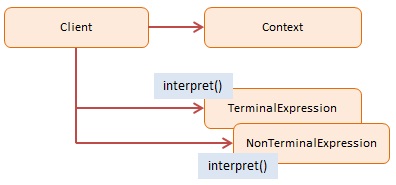Interpreter (ok)
https://www.dofactory.com/javascript/design-patterns/interpreter
Interpreter
Summary
The Interpreter pattern offers a scripting language that allows end-users to customize their solution.
Some applications are so complex that they require advanced configuration. You could offer a basic scripting language which allows the end-user to manipulate your application through simple instructions. The Interpreter pattern solves this particular problem – that of creating a simple scripting language.
Certain types of problems lend themselves to be characterized by a language. This language describes the problem domain which should be well-understood and well-defined. To implement this you need to map the language to a grammar. Grammars are usually hierarchical tree-like structures that step through multiple levels and then end up with terminal nodes (also called literals).
Problems like this, expressed as a grammar, can be implemented using the Interpreter design pattern.
Today, if you really need this type of control in JavaScript it is probably easier to use a code generator like ANTLR which will allow you to build your own command interpreters based on a grammar that you provide.
Diagram

Participants
The objects participating in this pattern are:
Client -- In sample code: the run() program.
builds (or is given) a syntax tree representing the grammar
establishes the initial context
invokes the interpret operations
Context -- In sample code: Context
contains state information to the interpreter
TerminalExpression -- In sample code: Expression
implements an interpret operation associated with terminal symbols in the grammar
one instance for each terminal expression in the sentence
NonTerminalExpression -- In sample code: not used
implements an interpret operation associated for non-terminal symbols in the grammar
Sample code in JavaScript
The objective of this example is to build an interpreter which translates roman numerals to decimal numbers: for example, XXXVI = 36.
The Context object maintains the input (the roman numeral) and the resulting output as it is being parsed and interpreted. The Expression object represents the nodes in the grammar tree; it supports the interpret method.
When running the program, a simple grammar tree is being built which then processes a roman numeral and translates it into a numeric.
Last updated